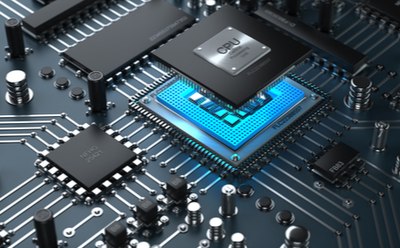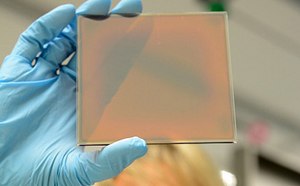Microelectronics & Nanoelectronics

Microelectronics and nanoelectronics are subfields of electronics in which the nominal feature sizes of electronic components are between 100 and 0.1 micrometers in magnitude (microelectronics) or 100 nanometers or smaller (nanoelectronics). The memory storage power of today’s advanced electronic devices has been achieved by significantly increasing the density of microchips. By decreasing the size of field-effect transistors, more components can be fit into integrated circuits, allowing for more powerful and energy-efficient electronic devices with reduced weights and power consumption.
Featured Categories
Our high-quality solution deposition and vapor deposition precursors are optimal for...
We offer a comprehensive portfolio of self-assembly and nanoimprinting materials for effective target surface modification and precise transferal of micropatterns and nanopatterns to enable high-performance micro- and nanoelectronics.
We provide a comprehensive portfolio of OFET and OPV materials and inks including organic semiconductors, organic conductors, dielectric materials and inorganic transport materials, as well as pre-patterned substrates and device components.
We offer a broad range of electronic chemicals and etchants used in electronic device fabrication, such as electroplating, lithography, etching, doping and packaging.
According to Moore’s Law, the number of transistors that can be put on a single chip will double every two years. Since this was projected in 1965, semiconductor fabrication technology sustained this rate of advancement and revolutionized the industry. However, pace of dimension reduction is slowing, and the key challenge in fabricating electronic components in the sub-micrometer range is the design of the transistor gate, which controls the current flow in the channel. The smaller electronic components are, the more challenging they become to manufacture. Physical and quantum effects alter materials’ properties from a macroscale to a nanoscale, influencing inter-atomic interactions and quantum mechanical properties.
The arrival of innovative materials, carbon nanotubes, boron nitride nanotubes, quantum dots, and graphene additives, have advanced the minimization of nanotechnology and microtechnology. These and other new materials can be shaped and manipulated with extraordinary precision at the tiniest of scales. Novel technologies enable the deposition and layering of electronic materials with precise thickness, even down to the atomic level. Thin-film semiconductor device fabrication technology uses conducting, semiconducting, and insulating materials to deliver advanced capabilities at high volumes and very low cost. Modern manufacturing methods for nanoelectronics include patterning (lithography), etching, thin film deposition, and doping techniques.
Emerging research fields focus on new approaches in nanotechnology and quantum mechanical effects. Molecular electronics uses single molecules as electronic components to establish electrical contact with bulk-sized electrodes. Spintronics, or spin-transport electronics, manipulates electrons’ spin property with magnetic and electric fields, resulting in a spin-polarized current that provides higher data transfer speeds and greater storage capacity, memory density and processing power than is possible with electric charge alone.
Visit our document search for data sheets, certificates and technical documentation.
Related Articles
- Graphene has emerged as the new wonder material. Being only one atom thick and composed of carbon atoms arranged in a hexagonal honeycomb lattice structure, the interest in this material has exploded exponentially since 2004 when it was first isolated and identified using a very simple method.
- Find unique properties & applications of single (SWNTs) , double (DWNTs) & multi walled carbon nanotubes (MWCNTs).
- Graphene oxide is a unique material that can be viewed as a single monomolecular layer of graphite with various oxygen containing functionalities such as epoxide, carbonyl, carboxyl and hydroxyl groups.
- Thermoelectric materials comprise a wide range of solid compounds distinguished by their ability to convert thermal and electrical energy.
- A solid and bench-stable alternative to sulfuryl fluoride gas has been developed, 4-(Acetylamino)phenyl]imidodisulfuryl difluoride (ASIF). ASIF is a shelf-stable, crystallilne reagent for the installation of the valuable SO2F functional group.
- See All (68)
Related Protocols
- Microparticles protocol for washing particles may be done via centrifugation. This procedure must be performed carefully.
- Our photoresist kit was designed to have the necessary chemical components for each step in the lithographic process. The component materials are provided in pre-weighed quantities for your convenience. Etchants are available separately so that the proper etchant can be chosen for a variety of substrate choices.
- The dispersibility and bundle defoliation of single-walled carbon nanotubes (SWCNTs), which can be applied to materials produced by the CoMoCAT® process, have been extensively investigated by SouthWest NanoTechnologies (SWeNT ®) and at the University of Oklahoma.
- Zirconium bromonorbornanelactone carboxylate triacrylate (PRM30) is a zirconium-containing multifunctional acrylate useful for producing cured, transparent films with high refractive indices.
- One of the best known and highest performing smallmolecule organic semiconductors is TIPS-Pentacene. TIPS-Pentacene is soluble in a wide range of solvents and does not require a thermal conversion after deposition.
- See All (5)
Find More Articles and Protocols
How Can We Help
In case of any questions, please submit a customer support request
or talk to our customer service team:
Email custserv@sial.com
or call +1 (800) 244-1173
Additional Support
- Chromatogram Search
Use the Chromatogram Search to identify unknown compounds in your sample.
- Calculators & Apps
Web Toolbox - science research tools and resources for analytical chemistry, life science, chemical synthesis and materials science.
- Customer Support Request
Customer support including help with orders, products, accounts, and website technical issues.
- FAQ
Explore our Frequently Asked Questions for answers to commonly asked questions about our products and services.
To continue reading please sign in or create an account.
Don't Have An Account?


